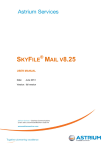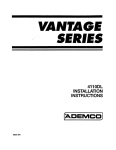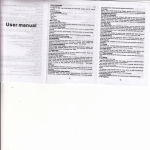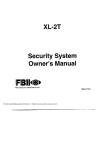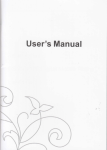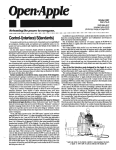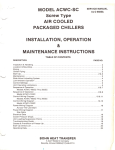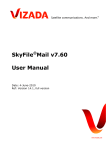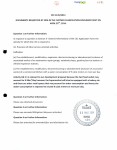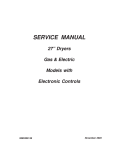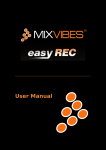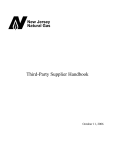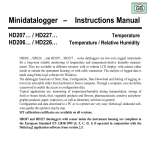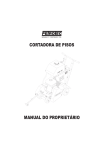Download 4150 v3 Installation Manual
Transcript
INDEX: PRODUCT EXTENSIVELY REVISED. MARGIN LINES INDICATE PRINCIPAL CHANGES IN THIS 8/87 ISSUE PAGE 1.General lnfonnatiin . . , . . . . . . . . . . . . . . . . . . . . . . . . . . . . . . . . . . . . . . . 1 II. System Description.. . . . . . . . . . . . . . . . . . . . . . . . . . . . . . . . . . . . . . . . . . 1 A. System Characteristics . . . . . . . . . . . . . . . . . . . . . . . . . . . . . . . . . . . . . 1 8. Zone Types and Definitions . . . . . . . . , . . . . . . . . . . . . . . . . . . . . . . . . 1 C.SystemOptions . . . . . . . . . . . . . . . . . . . . . . . . . . . . . . . . . . . . . . . . . . . 2 l Control Options .*........................,..............* l Communicator Options . . . . . . . . . . . . . . . . . . . . . . . . . . . . . . . . . . 2-g D. Zone Restore/Swinger Shutdown . . . . . . . . . . . . . . . . . . . . . . . . . . . . III. Functional Description, No: 4156 Remote Keypad -. . . . . . . . . . . . . . . 3 A. Keypad and LEDs . . . . . . . . . . . . . . . . . . . . . . . . . . . . . . . . . . . . . . . . . 3-4 4 8. Audible Signals . . . . . . . . . . . . . . . . . . . . . . . . . . . . . . . . . ..I........ IV. Communicator Operation . . . . . . . . . . . . . . . . . . . . . . . . . . . . . . . . . . . . . 4 A. Line Seizure . . . . . . . . . . . . . . . . . . . . . . . . . . . . . . . . . . . . . . . . . . . . . . . 4 B. Anti-Jam . . . . . . . . . . . . . . . . . . . . . . . . . . . . . . . . . . . . . . . . . . . . . . . . . . 4 4 C. Dial Tone Detection . . . . . . . . . . . . . . . . . . . . . . . . . . . . . . . ..-...... 4 D. PROM Calling Options ..,...............................*... 15.Acknowledgewait . . . . . . . . . . . . . . . . . . . . . . . . . . . . . . . . . . . . . . . . . 4 F. Transmission Format PROM Options . . . . . . . . . . . . . . . . . . . . . . . . . 4 G. Message Verification.. . . . . . . . . . . . . . . . . . . . . . . . . . . . . . . , . . . . . . 4 H. Ademco Low Speed Reporting Format.. . . . . . . . . . . . . . . - . . . . . . . 5 I. SESCOA/Radionics Reporting Fonats.. . . . . . . . . . . . . . . . . . . . . . . 5 V. PROM Programming.. . . . . . . . . . . . . . . . . :. . . . . . . . , . . . . . . . . . . . . . . 5 A. No. 691 PROM . . . . . . . . . . . . . . . . . . . . . . . . . . . . . . . . . . . . . . . . . . . B. No.696PROM . . . . . . . . . . . . . . . . . . . . . . . . . . . . . . . . . . . . . . . . . 6:l: VI. Installation and Wiring . . . . . . . . . . . . . . . . . . . . . . . . . . . . . . . . - . . . . . . 10 A. No.4150C-COM . . . . . . . . . . . . . . . . . . . . . . . . . . . . . . . . . . . . . . lo-11 B. No. 4156 Remote Keypad . . . . . . . . . . . . . . . . . . . . . . . . . . . . . . . . . . 12 VII. System Checkout . . . . . . . . . . . . . . . . . . . . . . . . . . . . . . . . . . . . . . . . . . . 13 VIII. Operation . . . . . . . . . . . . . . . . . . . . . . . . . . . . . . . . . . . . . . . . . . . . . . . 13-14 14 IX. Turning The System Over to User . . . . . . . . . . . ..I............... X. General Specifications . . . . . . . . . . . . . . . . . . . . . . . . . . . . . . . . . . . . . . . 14 List ot Illustrations: Diagram Diagram Diagram Diagram Diagmm 1: KMPAD’CONNiCTIONS . . . . . . . . . . . . ..I............... 2: KEYPAD CONNECTIONS . . . . . . . . . . . . . . . . . . . . . . . . . . . . . . 3: No. 4150 CONTROL/COMMUNICATOR.. . . . . . . . . . . . . . . . 4: No. 4156 REMOTE KEYPAD.. . . . . . . . . . . . . . . . . . . . . . . . . . . 5: SUMMARY OF CONNECTIONS . . . . . . . . . . . . . . . . . . . . . . . . 12 12 15 15 16 1. GENERAL INFORMATION: The No. 4150 Control/Communicator is a microcomputer based product which conveniently and economically combines the control panel and digital CoTmunicator into one package. This commercial-residential System provides every important feature required for a UL certified household fire/burglary alarm instaltation. Note: The telephone communication portion of the system is not part of a UL Listed household system. 11. Pulse dial call placement and data transmission. A typical system installation includes a No. 4150 C-CDM and up to four No. 4156 Remote Keypads. 16. Dual, selectable voltage operation, 6 or 12 volts. 12. Dual phone number calling with separate independent subscriber ID. 13. Double transmission message verification. 14. All reporting by zone for alarms. and restores. 15. Low battery reporting. B. ZONE TYPES AND DERNITIONS m NO. 4160 CCOM monitors all inputs and generates appropriate Output signals for interior and exterior audible warning as well as for remote communication to a central alam monitoring service. The C-COM has 7 zones. The zones are configured as follows: ZONE 1: FIRE ZONE - 24 hr. operation with trouble on open, alarm on short response. Pulsed alarm relay output. Alarm may also be activated by FIRE keys on keypad, it PROM enabled. ti NO. 4166 Remote Keypad(s) provide full system and individual zone status indication as well as system control. With the No. 4156. the system may be completely armed or just perimeter armed or disarmed. The entry delay may be turned off, zones may be shunted and user security codes may be changed. Two types ot emergency a!snns may be triggered (fire, silent or audibte emergency). A built-in speaker provides audible trouble and annunciator functions. ZONE 2: PROGRAMMABLE ZONE - Alarm on short only. ZONE 3: PROGRAMMABLE ZONE - Alarm on open only. ZONES 4-6: PROGRAMMABLE ZONES - Alarm on open or short. ZONE 7: PROGRAMMABLE ZONE - Alan activated by EMERG keys on keypad. II. SYSTEM DESCRIPTION A. SYSTBM CHARACTERISTICS Each programmable zone may be prqgrammed to respond as one of the following zone types: 1. Six independent wired zones, including five programmable zones and one fire zone, plus a seventh keypad activated zone. TYPE 1: AUDIBLE PANIC - Instant. 24. hr alarm with steady alarm relay output. 2. Keypad individual LED display of the zone identiiication tar alarms. alarm memory, and trouble conditions. TYPE 2: SILENT PANIC - Instant. silent, 24 hr. alarm. 3. Three keypad arm/disarm codes - master code PROM selectable and secondary codes user changeable from keypad (each uniquely reported to central station with open/close reports). TYF’E3: ENTRY/EXIT BURG - Entry and Exit delayed alarm while system is armed. Silent alarm or steady alarm relay output by PROM selection (see note below). 4. Chime mode, user changeable duress code, individual zone shunting - additional keypad functions. TYPE 4: PERIMETER BURG - Instant alarm while system is armed. Silent alarm or steady alarm relay output by PROM selection (see note below). 5. PROM variable entry/exit delay and alarm sounder timeout. 6. Alarm Relay output for audible alarms. 6. Power LED at the Remote Keypad to indicate that AC power is available and the battery is being charged. TYPE 5: INTERIOR BURG - Exit delayed alarm while system armed. Entry delayed alarm it initial entry is through the entry/exit zone (instant alarm otherwise). Silent alarm or steady alarm relay output by PROM selection (see note betow). 9. TEST/RESET Key on Remote Keypad to check the fire system functions. A programmable zone may also be programmed to make no response. 7. Arming status outputs with both polarities for memory control Of motion detectors. 10. Multi-format communicator (Ademco Low Speed. SESCOAIRadionics). NO= I The burglary zone types are programmable for silent alarm or steady alarm relay output as a group. . RparlJpAtlll C. BYSTBY OPTIONS The system can be configured in a number of ways. This allows the user to customize the system for his own particular needs. Before actualty making the choices which affect how the system operates (See Section V PROM Programming). it is important to understand the options. The discussion that follows broadly divides those options into two categories: control options and communicator options. conlrofoPtlons The system may be PROM selected to power up in either the armed or disarmed state atter sn extended power outage during which AC power is test and the back-up battery is depleted. Upon restoration Of AC power, the keypad sounder will sound a steady low level tone for 1 minute. During this 1 minute period, the user may abort the power up am’! Sequence by pressing any key. At the end of this 1 minute period, the system will shunt any burglary zones which are faulted and will then arm itself. Bypass and closing reports are transmitted (ii PROM enabled) to the central station, Code 9 will appear as the user number in extended closing reports to indicate to the central station that the system armed itself. 1. Entry Delay, Exit Deley The entry delay is the time between entering the premises and when the system must be disarmed to avoid activating an alarm. The exit delay is Me time between aming the system and when the premises must be.extted to avoid activating an alarm. The entry and exit delays may be independently PROM selected to be between 0 and 120 seconds in 8 second increments (45 seconds maximum for entry delay and 88 seconds maximum tar exit delay when used in a household burglary UL Standard 1023 Listed application). 2 Communkator *mmunlator 0) openmoee D&y Repotls A closing report, 1 PROM enabled. will be sent whenever the system is completely armed or just parimeter armed (i.e.: STAY mode operation) The communicator delay for closing reports is fiied at 15 seconds. The system may be disarmed during this period without either closing or opening reports being sent to the central station, b) Extended Report8 3. Belwslron Theoul If PROM enabled. the system will report additional information to the central station. This information includes: Bell/Siren audible indication may be PROM selected to tast between 0 and 15 minutes in 1 minute increments (4 minutes minimum when used in a household burglary UL Standard 1023 Listed application), after which it “times out”. The fire zone may be optionally selected to have its alarms not time out, wherein manual shutdown would be required to sikmce a fire alarm (for household fire UL Standard 985 Listed applications, the tie atann musl not time out). (1) Zone identification associated with transmission of a Restore. (2) User identification at the time of dosing and opening. Use of: secondary security code al is identified by “1” secondarysecurity code #2 is identified by “2” master security code is identified by “4” 4. Pallc zone opthwl NOTE: Code 9 appears as me user u when the system powers up armed after an extended power outage. The system offers two panic zone types - silent panic and audible panic A programmable zone may be configured as either type by PROM selection. Zonn Enablea The system may be PROM programmed to transmit any combination of the following messages: The system may be set up to delay the triggering of the communicator for burglary alarms by 15 seconds. This feature may be used to reduce false alans due to user errors. See Communicator Options section for comments on open/close and trouble reporl communicator delays. 5. Butglq Otiionr: 1. Communlutor c) Plre Troubh Rqmrb The system will transmit a troubte report. if PROM enabled. whenever a trouble condition is sensed in the fire zone and has been present for at least one minute. When the troubte condition has restored, and remained restored for l-2 minutes. a restore message will be sent. Option The system offers mme burglary zone types - entry/exit, partmeter and interior. A programmable zone may be configured as any one of these types by PROM selection. The burglary zones may be configured for silent or audible alarm by PROM selection for all of the burglary zones as a group (silent alarm may not be selected when in a household burglary UL Standard 1023Listed application). d) Cancel Ropori If PROM enabled, the cancel report will be sent if a burglary alarm is turned off (cancelted) before the betl/siren times out. If opening reporting is enabted. the cancel report will be followed by an opening report Cancel reporting doesnot apply for fire or panic alarms. a soamy code This 4 dtgl code restricts the use of the system to only those who know me code. Any digits, including repetitions. may be chosen. There are mree such codes (not including the duress code descrtbed below). One is PROM programmed at installation andthe othercodes era user changeable from a keypad at any time, using the master code to enable the change. l ) Duras Roporl A duress report, if PROM enabled, will be sent whenever the system is armed or disarmed using secondary security code ff3. This system code is reserved for duress alarm activation. 7.DumaCode NOTEr Duress reports are not accompanied by either opening or closing reports. The duress code is a separatesecurity code. Its purpose is to allow someone to initiate a silent panic condition but still give the impression that the control is working normally. For example. if one codeis1234~theduresscodeis1235,enteringl234willCa~ the system to disarm, but entering 1235 (assuming one is in a hostage sttuation) will cause the system to disarm, but will also trigger the communicator to aand a sitent panic message. H used with the No. 691 PROM (see Sectiin V PROM PROGRAMMING), a Zone 2 report is transmttted. If used WiM the No. 696 PROM, a Zone 7 mport is transmitted. f) Teat ReporI As delivered.the system has the capability to transmit a manually initiated (CMND+ “5” keys) Test report to the central station if the reporting code for Test is PROM programmed. It it is desired to send the Test report automatically, as a means to verify that the communications link between the protected premises and me central station is operative, a second PROM option is offered - 24 hour test. With this opt& selected. the system tniiites a Test message call every 24 hours, starting 12 hours after the time of instatlation. This option goes into effect at tnstaltabon ttt tf PROM enabled. If any other transmission is sent by the system during the ensuing 24 hour period (e.g. open and closing reports), then the test message is not sent. NOTEr It the user of the system inadvertently programs a duress code that is the samaas the master code, the duress Silent panic capability is suppressed to avoid the transmtsaion of tatse alarms to me central etarm monitoring service. abd~z0n0(wllatlng m (Rummy) Phone Numkr Abe 2Roportto The system altows for the various communicator reports to be dii between two central stations (or two receivers). This is done in aome sttuations where, for example, all alarms may be routed to a primary alarm receiver white non-critical items, such as troubtes or individual zone ahuntii allows a uaar to arm the system even though certain burg&y zonas are fautted or will ba later faulted and abctuktn’t cause anatarm. Such zones can be Shunted white the system is disarmad by depressing the CMND and BYPASS keys and by then totlowing wtth the number of the zone to be shunted. Nate #tat 24 hr zones carm~l be shunted. 2 . opening and closing reports, might be routed to,a secondary, : receiver. l Prlrnary l Phone Number The bypass mode is exited by depressing the CMND key. The bypass mode will be exited automatically if no key is depressed for a1 feast 30 seconds. Once me mode is exited. the BYPASS LED will ba on steady U one or more zones were shunted. Note that all shunts are removed automatically when the system is disarmed. . A bypass report is hansmined along wfth a closing report-(if PROM enabled) at arm time if one or more zones were shunted. A bypass restore report is transmitted along with an opening report (if PROM enabled) at disarm time if any shunts were in effect. lNSTANT Key and LED (YeSow): When depressed subsequent to entry of the security code and the CMND key. the burglary system will arm with the entry delay disabled on the entry/exit and interior zones. making them instant alarm zones tor subsequent entry. The INSTANT LED is lit when me system is in this mode. The entry delay for these zones is restored subsequent to the system being disarmed. This LED also has a secondary designation as the Zone 5 LED. When the ZONE DISPLAY key is held depressed this LED is on steady for current violation and flashes for memory of alarm on Zone 5. The latter indication is not cleared until the system is next armed. Asslpnmont Fire, Zone 2 Alarm, Zone 3 Alarm, Zone 4 Alarm, Zone 5 Alarm, Zone 6 Alarm. Zone 7 (EMEAG Keys) Alarm and Cancel. Seoondary Phone Numkr Anlgnment Open, Close. Restore, Low Battery, Trouble, Test, Bypass It is possible to PROM select. by specific report. which reports are desired to be sent to the other phone number too (e.g. Restore). 3. Communtcatot Code Mgnmsnl Each alarm zone in the system may be assigned its own communicator code. How the zones are assigned to codes affects the reports that wilt be sent. As an example, each zone could be given a dierent communicator code for unique zone reporting. Gr the zones could be grouped by function with duress/silent panic (common rep&ting code) zones as Code 2, the fire zone as Code 1, and the burglary zones as Code 3 (this would allow the system lo be compatible with an existing central station alarm code scheme). 4. Communlator Format CODE Koyz When depressed prior to entry of the master security code, will permit the immediate (within 10 seconds after master code entry) entry of a code designation (1.2. or 3) and a secondary user changeable 4 digit security code. The code designation of 3 is used for entry of the duress code. The duress code permits the performance of all of the functions of the master code exceot secondary code change. The other secondary codes permit the performance of all of the functions permitted by the PROM programmed master code except secondary &de change. Repeating digits are permitfed in code entries. Individually selectable for primav and secondary telephone numbers - Ademco Low Speed or SESCOA/Radionics. 2. ZONE RESTORE/SWINGER SHUTDOWN .&rce a zone is faulted, it will be re-enabled for local alarm sounding at timeout or whenever if becomes intact, whichever is later. n will be reenabled for central station reporting only after it has remained intact for at least l-2 minutes. A restore message will be sent. if PROM enabled. to the central station al this time. - CHIME Key: When depressed subsequent to depression of the CMND Key during the disarmed state. will cause entry to a mode where any fault in the Entry/Exii Burglary Zone will cause a brief loud tone to ba heard at each remote keypad. The mode can be left by subsequent redepression of the CMND and CHIME keys. The CHIME mode is in effect during the armed state but is not heard because the entry delay warning sound overrides the other sound. NOTI? If two or more zones are PROM assigned the same alarm reporting code, then multiple restores using this code will bs transmkted. The 1 minute communicator disable, in conjunction with automatic shutdown of a zone after it reports 3 alarms within a single armed period. is intended to prevent annoyance calls to the central station for swinging zones. The shutdown of the zone is accomplished by automatic bypass of the zone after the 3rd alarm report, indicated by the BYPASS LED lighting steadily. central station reporting for fire and panic alarms will be re-enabled l-2 minute5 after a security code is entered to silence these types of alarms (provided that zone is not fautted during the l-2 minute period). II. FUNCTIONAL DESCRIPTION, KEYPAD (See Diagram 4) READY LED (Qraea): The READY LED is lit whenever all burglary zones are intact (ready for arming) during the disarmed state. It is off whenever a zone fault is present. This LED flashes as a memory of alarm indication (along with the ARM LED) in the armed state for audible alarms. This memory of alarm indication is removed by entry of the security code. This LED also has a secondary designation as the ZONE 3 LED. When the ZONE DISPLAY key is held depressed, this LED is on steady for current violation and flashes for memory of alarm on Zone 3. The latter indication is not cleared until the system is next armed. No. 4156 REMOTE A KEYPAO and LEDs Keys o-9: These are used to enter the arm/disarm security code(s) and the duress code. STAY Kay and LED (YeBow): When depressed subsequent to depression of the CMND Key in lhe disarmed state. shunts fhe fnterior burglary zone. The STAY LED is fii then and remains lii when the system is armed. This LED also has a secondarv desionation as the Zone 2 LED. When the ZONE DISPLAY key is held deiressed, this LED indicates the state of Zone 2. providing current violation status (on steady) as well as memory of alarm [flashing). The latter is not cleared until me system is next armed. flRE and FIRE Kom Simuttaneous depression of both keys causes manual activation of the fire alarm (if PROM enabled). EYERG and EYERG Koyr: Simultaneous depression of both keys causes manual activation of a Panic Zone alarm (audible or silent as a function of zone programming) or no action (dependent upon programming). TROUBLE LED (RED): If one or more of the following conditions has occurred, the TROUBLE LED will be lit steadily and an audible trouble signal (short beep) will be heard every 15 seconds: (1) An opan circuit occurs in me fire zone. (2) A security code is entered subsequent to a fire or panic zone . violation and the zone is still violated. POWER LED (Oman): This LED indicates the presence of AC power to operate the system. The LED will immediately flash when AC power is lost and the system is operating from its standby battery. If one or more of the following conditions has occurred. the TROUBLE LED will flash and no audible trouble signal will be heard: This LED also has a secondary designation as the Zone 6 LED. When the ZONE DISPLAY key is held depressed. this LED is on steady for current violation and flashes for memory of alarm on Zone 6. Tha latter indication is not cleared until fhe system is next armad. BYPASS Kay and LED (yellow): Depression of the CMND and BYPASS keys causes the system to enter fhe bypass moda. While in this mode. the BYPASS LED will flash as confirmation that me mode is in effect. A flashing zone LED indicates that a zone is faufted and not yet shunted while a steadily Iii LED indicates brat a zone is shunted. A zone may be shunted or unshunted by depressing the key corresponding to its zone number. Note that zones may be shunted only while the system is disarmed and that 24 hour zone5 may not be shunted. (1) The fire circuit fails to reset following the silencing of a fire alarm using the TEST/RESET command (see below). (2) The fire zone remains faulted after the fire alarm has timed out (if time out is PROM enabled). (3) The audible trouble signal is silenced using the TEST/RESET command but steady LED and intermittent beep may return after 24 hours if the condiiion remains. (see below). The TROUBLE LED will turn off as soon as the condkion that caused it to be lit is eliminated. This LED also has a secondary designation as fhe Zone 4 LED. When the ZONE DISPLAY key is hetd depressed, this LED is on steady for current violation and flashes for memory of alarm Zone 4. The latter indication is not cleared until the system is next armed. 3 TEST/RESET Keys If neither a fire alarm or trouble condiiion exists. depression of this key subsequent to depression of the Ch+fNDkey will cause fire test to be performed. AC derived power is automaticallv turned off fPOWER LED will flashl 50 that the alarm soundbr is powered for a 2 second test f;om the standby battery. During the test. the TROUBLE LED will flash for 14 seconds. If TROUBLE LED flashes but alarm sounder fails to sound, battery must be chacked as it may be disconcectad or may not bs fully charged. A. LINE SEUURE A Double Pole Double Throw relay disconnects all extension phones on this telephone line 50 that the communicator Cannot be f--Y .Mocked by outgoing calls or by a phone left off hook. The System Ii ,; then executes a short hang-up, to insure a disconnect in-se an outgoing call was being made, and attempts to estaollsh a communication link. If the system is unsuccessful in establishing the link, an anti-jam procedure is executed (only effective if the telco network used features “called party disconnect”). If there is trouble on the fire or the oanic zones. the TROUBLE LED will be iii and a short beep wili be heard &ery 15 seconds Depression of the CMND and TEST/RESET kevs will silence thi beep and cause the TROUBLE LED to flasti for 24 hours or until the trouble condition is removed, whichever occurs sooner. In this condition, the alarm sounder will not sound. If the condition remains after 24 hours. the LED will light steadily again. accompanied by the audible trouble beep. 8. ANTI-JAM Many U.S. telephone networks will automatically disconnect the calling party if the called party hangs up for a period of time. The system automatically executes a 25 second anti-jam (hang up) AFTER the first call attempt and each successive call to prevent any incoming calls from blocking transmission. The communicator link is established in the following manner. The system checks for a dial tone. If there is a fire alarm present, depression of the CMND and TEST/RESET keys will silence the alarm and reset the fire circuit. The TROUBLE LED will flash while the fire circuit is beino reset. If the flashino indication does not turn off within I4 sec&ds. the fire circuit hgs failed to reset. The ARM and READY LED5 will flash as memorv of alarm indications until a security code is entered. - C. DIAL TONE DETECTION In order to reduce response time, the system senses the.inltial local (PABX) or external (telco) dial tone. If a dial tone is detected, the system dials using the rotary dial format. If a dial tone is not detected within a PROM programmed waiting period. the system will dial anyway, as it assumes that a good connection has been made and that the dial tone is not clear. 4 (INSTALLER TEST) Key: Depression of this key, subsequent to depression of the CMND key during the disam\ad state, will place the burglary system into an Installer Test mode. Any violation of a burglary zone will cause the alarm sounder to activate briefly. While the system is in this mode, depression of any key will terminate the mode. The waiting periods for the InlUal diil tone are: l 6 (COMMUNICATOR TEST) Koyz Depression of this key, subsequent to depression of the CMND key al any time, will cause a test report to be made to the cemral alarm monitoring service (assuming that the Test Report was PROM enabled). . l NOR ARM LED IRedd): The ARM LED is lit whenever me burolarv System is either completely armed or just perimeter armed (i.e. STAY mode operation). This LED flashes as a memory of alarm indication (applies ori for audible alarms). The ARM LED also flashes after arming during the exit delay period. It is off when the system is disarmed except as a memory of alarm indication for fire or audible panic. This LED also has a secondary designation as the Zone 1 (Fire) LED. When the ZONE DISPLAY key is held depressed, this LED is on steady for a current Zone 1 trouble condition and flashes for memory of alarm on Zone 1. The latter indication is not cleared until ihe system is next armed. ImaIM Code Entry: D. PROM CALLING OPTlONS Troubk: Brief beep tone every 15 5econds for a fire zone trouble, or for a fire or panic zone violation at power-up or after alarm silencing. Enby Wamlng: Steady tone activated during the entry delay period. Chlme Annunci8uOn: Single beep tone each time Entry/ExiiBurglary Zoneisfaulted when in this mode. Key Depmsslon Power Up Ant I Feedbadc E. ACKNOWLEDGE WAIT l 60 seconds - standard. Message transmission will bagin when the acknowledgment is received. F. TRANSMISSION FORMAT PROM OPTlONS Brief beep tone for each key not in the dual key panic section of the keypad. Steady tone sounded tar 1 minute v&ten AC power returns following an extended power outage. during which back-up battery was fully depleted. IV. COMMUNICATOR OPERATION system is not UL Listed.) i Dual Report - Attemate between first and second number until one sends kissoff and then concentrate on calling the other until the maximum number of anempts is reached. l Prhnary Numkr Only - Certain alarm code/channels report only to the primary number (e.g. fire zone alarms, etc...). l Seoond Numbar Only - Certain alarm code/channels reporl only to the second number (e.g. open/close reports). Succe55tul connections are verified when me system receives an acknowladgment lone from the central station receiver. 11this tone is not received within a defined period. the system will dinned from the line and watt 30 seconds before trying again. The calling procedure will be repeated in varying combinations, as programmed. until a successful link is established or until the maximum number of attempts is reached l 5-6 consecutive brief beep tones. One beep tone. If a PABX access code is programmed, men a 7 or 25 second pause, whichever is PROM programmed, is executed baiore the external Tetco digits are dialed. The system.dials up to two separate 15 digit telephone numbers. It may be programmed to do thii in a number of ways. B. AUDIBLE SIGNALS System Ammd: 7 seconds - for quick disconnect PARX system (only if PABX access code is PROM programmed). 7 seconds - for normal response telco systems (PROM selectable). 25 seconds - for slow response telco systems (PROM selectable). l l Ademco Low Speed (10 pulses per second), 1400 Hz ACKlKissoff. l SESCOA/R&dionics (20 pulses per second), 2300 Hz ACKIKissoff. NO= Extended reporting from each of the above formats is separately PROM 5electabte. To ensure proper transmission, each message is sent up to four times. As soon as the central station receiver verifies the message. it sends a “Kissoff” tone to the system. 0. MESSAGE VERlFlCATlON (This portion of the l The communications capability of the system links it with a monitoring central station using the felephone 5witched network. When alarm, trouble, or status intormation is to be communicated, it is translated into a message appropriate to the format selected via the various PROM options described previously. The system then seizes fhe phone line. Two successive identicel messages - Ademco No. 673 and 685 receiver5 as well as Adcor. Franklin, Radionics. SESCOA Silent Knight, and Vertex receivers. If the system does not receive the Kissoff tone, it will disconnect and dial again. It will make up to 6 anempts to obtain kissoff via the primary and secondary phone numbers. 4 .. ;. . H. ADEMCO LOW SPEED REPORTtNQ FORMAT This message consists of either 3 or 4 dig&r (blank r&sncoded digits are not transmitted) of the subscriber identification number and a single digit alarm code, PROM assigned to that alarm/trouble/status report. If more than one alarm is triggered, the alarms will report in tollowing order: tire, Zone 2 alamx Zone 3 alarm, etc. unless the subsequenl alarms trigger while one or more alarm messages have already m transmission. Up to four alarms may be stacked for transmission. Each message must receive kissoff betore the next is sent. utilize fixed interdigit timing. whereas older models require the use Of variable ihte’rdigk timing (to shrink the overall digit-to-digit time to an acceptable level). See No. 696 PROM Programming Step 21. II should be further noted that the following report code assignments are required for the Radionics tormat in order to attain the appropriate English language printout and display at the Radionics No. 6000 receiver. They apply as well to the Ademco Low Speed and Radionics formats for English language printout at the Ademco No. 665 Receiver. : D E F Example: It codes 3 and 6 of Subscriber 690 are to be reported, the system will respond as follm: ‘Reflects that two identical messages verification is used. Optional Extended ReportIn V. PROM PROGRAMMING. Ca~llltloa Extended reporting operates as follows for each of the below cited examples: . Alarm Restoral Message Sent = 690 A RRR A Where: Fl 5: Restoral code selected A = Alarm code PROM assigned to restored zone 690 = Sample Subscriber Account Number l trouble Restoml Message Sent = 690 R RRR T Where: R = Restoral code selected T = Trouble code selected. l U8ef IdentlticMon l ZONE 1: FIRE ZONE 2: PANIC, SILENT or AUDIBLE by PROM selection Note also that when a No. 691 PROM b wad. Troubb nnd Troubk~ Rutore -ports arm tmwnltted In @ace of &no and Sy~8u RoUom reports. The fatter can be suppressed (no report for a bypass or its restoral) vie a PROM option (see No. 691 PROM programming Data Group 1). The No. 691 PROM may be programmed using the Ademco No. 690 PROM Programmer. Fill out the appropriate programming sheets and keep as a recotJ ot the system’s configuration. CUSTOMER NAME CUSTOMER NO. CUSTOMER ADDRESS Shunted Zone Restore Rbporl Message Sent = 690 R (standard tomtat) 690 A (extended format) RRR B Where: R = Restoral Code selected B = Bypass Code selected. 0 AC Power Restoml Where: NOTE: Program the numbers that you write into the boxes 1 To program, set Phone No. Selector Switch to “Primary” and Rotary Switch to Position 1 (“Access s”) on No. 690 PROM Programmer. L = Low battery/AC loss Code selected R = Restoral Code selected NOTBSr The system sends a true low battery report but the restoral report transmitted is for the restoration of AC power. I. SESCOA/RADtONIC&REPORTtNG A: No. 691 PROM USED PROM Data Glwp Message Sent = 690 R RRR L 0 A No. 691 (blank) or 691Pt (Ademco programmed to customer order) PROM is used if the installer desires the C-COM software to automatically configure the zones as follows: Shunted Zone Retort Messaae Sent = 690 B Where.’ 6 = Bypass Code selected NOTBS: 1. This report is sent reoardless of whether standard or extended lormat is PROM selected. 2. This report is not sent if STAY arming is ubfized. l The system employs either of two PROM integrated circuits tor selection of system options. A No. 696 (blank) or 69681 (Ademco programmed to customer order) PROM is used if the installer desires to program zone type for each of the programmable zones. The No. 696 PROM may be programmed using a NAPCO PRO 410 Programmer or an Ademco No. 699 Intelligent Programmer. at O~on/CIo80 Message Sent = 690 C ccc u Where: C = Closing code selected Where: U = User ID number, 1.2.4. or 9 (1 = Secondary Code #I. 2= Secondary Code #2,4 = Master Code, 9 = system powered up in armed state toflowfng extended power oa3H. NOTBr Similar for Opening report except that Closing Code is replaced by the Opening Code. 0 Open Close Cancel Restore Trouble NOTI? If a burglary alarm transmission is in process and the security code is entered at a 4156. the unit will continue the transmission and then send a Cancel report. Any other burglary reports awaiting transmissron are cancelled. 24 hour reports (tire, panic) will not be cancelled. 690 6 690 6 Final kissoff (system hang- up) 690 3 690 3 Kissoff = = = = = FORMAT The message structure used for this format is similar to that used for the 9demco Low Speed tonat. However, the full hexadecimal code set (O-9, 3-F) can be used. It should be noted that the hexadecimal code set can be Qed for the Ademco Low Speed format but only on receivers Capable of fecoding. displaying and printing the message data (the No. 6601673 3eceivers can only accommodate the code set of l-9). -wo options are availabfe (when the No. 696 PROM is used), depending lpon the model of SESCOA receiver being used. Current models can PABX A- Co& (Select from 0 - 9): c] c] 0 DebylPanidSyF8ss OFtbn8z The standard external Telco dial tone waif period to initiate a telephone connection is 7 seconds. It is possible, however, to optionally select an extended dial tone wart period of 25 seconds tor slowfy responding Telco systems. Normal Burglary reporting is instantaneous upon tripping of the alarm. It is possible, however, to optionally select a t 5 second delay in the reporting of the burglary alarm to the Central Alarm Monitoring Service so as to give the user an opportunity to turn off the system subsequent to a false alarm prior to alerting the Central Alarm Monitoring Service. All closing reports are automatically delayed by 15 seconds. All troubfe reports are automatically delayed by 60 seconds. 5 . The panic zone needs to be programmed for either silent alarm or audible alam operation. The transmission at a troubte report al closing lime if a zone has been bypassed can be enabled or disabled. Enter BH vaNs sahctod Bit Vdua 1 2 4 6 Select if 25 second Diil Tone Wail is to be used (Do not select if 7 second Dial Tone Wait is to be used). PROM Data Group 5 To program, set Phone No. Selector Switch lo “Primary” and Rotary Switch to Position 3 (“Subs ID#“). See Note t under t--J i PrlnUry SubscrIber I.D. (Select from 0 - 9): PROM Dab Group 7““’ 0nlJo PROM D&a Group 6 To program. set Phone No. Selector Switch to “Secondary” and Rotary Switch to Position 3 (“Subs IDa”). SeeNotes1.3 Secondary Subscriber I.D. (Select trom 0 - 9): under PROM Data Group 7 Select if Burglary Reporting istobedelayedby15 seconds (Do not select If Burglary Reporting is to be instantaneous). ODD13 PROM Dala Group 7 Salect if Panic Zone Response is to be Audible (Do not select if Panic Zone Response is to be silent alarm). To program. set Rotary Switch to Position 4 (“Not Used”) and raise switches for checked boxes representing bits set within the hexadecimal code. Reporllng Codm lor Closing and Dureu/Ponlc B -F): Select if trouble reporting is to be suppressed when the system is armedwithazonew. ‘I Addlhenluus8kctd I will be required for this data group. On the first pass, program the PABX Access Code plus the appropriite first pass entry shown below. On the second pass. repeat the same PABX Access Code entry and then the second pass entry shown below. 10 11 2 8 : 12 “B (Select trom 0 - 9. I l Nohr: 1. If this total is greater than 9. a two pass programming procedure , FOR TOTAL: PROGRAM: First Pass: Second Pass: 13 14 15 : t : 2. If it is desired to program fewer than three PABX digits AND it is desired to program thii number, follow this procedure (Ior each pass): Program the one or two PABX diiits. Press down on the PROM PROGRAMMER’s “VIEW button (labeled “*“) and release it when a buzzing sound is heard. Again, press down on the VIEW button, but this time release il onfy after the display has flashed three times. The programmer is now ready to accept the dii to be programmed. If a second pass is required (per Note 1). repeat this entire step for the second w= efw. PROM Data Group 2 To program, set Phone No. Selector Switch to “Secondary” and Rotary Switch to Position 1 (“Access #“) on No. 690 PROM Programmer. Muter Sea~ftty Code (Select from 0 - 9 digit set. repeating digii permitted). t----’ 1 2 BitWeight 1 2 SWITCHES 3 -4 4 0 Duress/Panic (Zone 2) 5 6 7 8 1 2 4 a (ex: 7 = 1+2+4. B = 1+2+8, C = 4+&D = 1+4+8. See chart at end of this section) NOTES: 1. Leave 4th digit blank if only 3 subscriber I.D. digits are to be f reported in the communicator message. 2. Central station reporting of trouble, burglary alarms. tire and panic alarms, etc. can be disabled if the corresponding reporting code is left blank (i.e. unprogrammed). PROM Data Group 6 To program, set Rotary Switch to Position 5 (“Sys Options”) and raise switches tor checked boxes representing bits set within the hexadecimal code. Re~wlhg Codm lor Opmhg and Fire (Sehxl ham 0 - 9. B - F): q ~clcl To program, set Phone No. Selector Switch to “Primary” and Rotary Switch to Position 2 (“Main #“). Numbar (Select from 0 - 9): (leave unused diiits blank) “. 3. If it is desired to have the communicator report all messages to a single receiver, the secondary telco number and subscriber I.D. should be programmed the same as the primary telco number and subscriber I.D. The PROM locations for primary number only and secondary number only reporting options should be left unprogrammed. PROM Dala Group 3 PrImmy T&o 1 Bii Weight t lJDuuI3DoOOOOo PROM Data Group 4 To program, set Phone No. Selector Switch to “Secondary” and Rotary Switch to Position 2 (“Main #“). SeeNote3tmder Socadwy Tdco Numkr (Select from 0 - 9): PROM Data Group 7 (leave unused diiits blank) 6 2 4 8 I I 1 2 4 8 . PROM Data Group Q To program. set Rotary Switch to Position 6 (“Inverted”) and raise switches for checked boxes representing bits set within the hexadecimal code. PROM Data Group 12 To program, set Rotary Switch to Position g (“OpenlClOSe”) and Set switches for checked boxes. Atarm Sounder Timeout (Select from 0 - 15 mrnutes) 8nct Reporttng Code tor Cmcel (Select from 0 - 9. B - F): Note: 4 minutes minimum timeout for household UL Listed applications 8nd Fomuts and Communlwtor R.porUng Chwuterbtkn Prlmay Tobphono Number ALSO (Check as desired): SWITCHES 1 SWITCHES 3 4 I I 2 I 2 811Weight 1 4 6 5 6 I 1 7 I .2 6 I I 4 Report. to 1 6 PROM Data Group 10 TO program, set Rotary Switch IO Position 7 (“16 set Delay”) and raise switches for checked boxes representing bits set within the hexadecimal code for switches 1 - 4 and set other switches for checked boxes as indicated. 5 7 6 6 fxlt Delay Time (Select 0 - 15 times 6 sets) l d Communicator Ropoti to Second Tolephone Number ALSO: (Check reports for which desired) (0 - 15) Note: 7 max. (60 se&. max. allowable) for household burglary UL Listed applications. r-l ! 1234 Exit Delay Time (increments of 8 seconds) 5 FIRE (ZONE 1) SWITCHES 6 DURESS PANIC (ZONE2) I 7 6 PERIMETER ENTRY/ #2 BURG WIT BURG (ZONE 3) (ZONE 4) REPORT TO PRIMARY TELCO NUMBER IN ADDlTtON TO SECONDARY NUMBER PROM Data Group 13 To program, set Rotary Switch to Position 10 (“Restore”) and set switches for checked boxes as indicated. Mlacellaneour Audible Opttons and Communlwtor .Telaphone Number ALSO (Check as desired): Bit Weight- I -I REPORT TO SECONDARY TELCO NUMBER IN ADDtTlON TO PRIMARY NUMBER -.I Report to Prtnwy SWITCHES 1 2 PROM Data Group 11 3 4 tLMED POWER To program, set Rotary Switch to Position 6 (‘Secondary U Only”) and raise switches for checked boxes representing bits set within lhe hexadecimal code for switches 1 - 4 and set other switches for checked boxes as indicated. Entry Delay Time (Select 0 - 15 times 6 sets.) and CommunlcMor Report to Second Tetephone Number ALSO: (Check reports for which desired) ‘0 - 15) Note: 5 max. (45 sets. max. allowable) for household burglary UL Listed applications. II SWITCHES 1234 ixit Delay Time increments d 6 seconds) I I I 2 4 6 Bit Weight L 5 PERIM. ftl BURG (ZONE 5) 6 INTERIOR BURGLARY (ZONE 6) 7 KEYPAD EMGY KEYS (ZONE 7) 6 CANCEL I t REPORT TO SECONDARY TELCO NUMBER IN ADDtTlON TO PRIMARY NUMBER - I I I REPORT TO PRIMARY TELCO NUMBER IN ADDlTlON TO SECONDARY NUMBER ‘Murt be audrble for household burglary UL Listed applrcatrons. “No trmeout must be selected lor household fire UL Listed applicatrons. . PROM Data Group 14 To program, set Rotary Switch to Position 11 (“Not Used”) and raise switches for checked boxes rapresenting bii set within the hexadecimal code. RwCodasforTrw#r/Zorw (SelectfromO-9.6-F) Nom coding chart Bit Weight code ---0 (10) Bypaa and Pwlmotor al Burghy 2 l 6 4 1 Noted Trouble is transmitted when the system is armed and a zone has been bypassed (as an indication of that bypass). 2 3 4 5 6 7 6 1 SWITCHES 3 4 2 5 6 7 9 6 B(ll) 3 4 2 BPWeight 1 PROM Data Qwp 8 1 2 4 6 D (13) E (14) 15 F (15) r?l To program. set Rotary Switch to Position 12 (“Not Used”) and raise switches for checked boxes representing biis set within the hexadecimal co&?. Reporllng Codas lor Tosl and Ink&r P (12) c Test 1 2 SWITCHES 3 4 Bit Weight 1 2 4 Burglary (Select from 0 - 9, B - F) P Interior Burglary (Zone 6) CAUTION: Throughout these reporting selections, the ability to select full Hexadecimal reporting codes is indicated. Make sure that the receiver, into which your signals are being reported. is capable of accommodating such reporting. For example, the Ademco No. 660/673 is only capable of accepting 1 - 9 for all reporting codes. B. No. 596 PROM USED ??I 6 7 6 1 2 4 6 If Ademco’s No. 699 intelligent Programmer is used, the instructions for programming the PROM are provided with the No. 695-50 Programming Cartridge. I PROM Dme Qrwp 6 15 To program, set Rotary Switch to Position 13 (“Not Used”) and raise switches for checked boxes representing bits se1 within the hexadecimal code. Roporllng -9. B - F) Codes for Rutom If NAPCO’s PRO-410 Programmer is used, the following instructions wtW CUSTOMER NAME CUSTOMER NO f--l ‘_ <, .’ CUSTOMER ADDRESS and Pwlmeter 42 Burglary (Select from 0 Perimeter #2 Burglary (Z3) Fb.SiO~ P P 1 2 SWITCHES 3 4 5 6 7 Select from O-9 (NOlEz first digit location = 000) 6 2. SECONDARY TELCO NUMBER 1 Bitweigtlt1 2 4 6 1 ? 4 6 PROM Data Group 17 LOCATION To program, set Rotary Switch to Position 14 (“Not Used”) and raise switches for checked boxes representing bits set within the hexadecimal code. RopoMng C&OS for Low BMtmy and Entry0 -9. B - F) BurgW (select from II 11 11 11 11 11 004 005 006 007 006 009 010 011 012 013 014 015 I (NOTE: first telco digit location = 004) Select from O-9 NOTEz If ll b dealmd to have lhe communicator reporl all meuogea to a rlngk mceiver, the oecondafy Wco number should be programmed the smne as the p&nary i&co number. PROM lowtladu 080, 081.Og2 should not be programmed and only In loation 063 md be consldend. thOBttV8lWQMbOUOll 3. PRIMARY SUBSCRIBER ID 1 o,6 I o17 I o,6 I o1 g 1 LOCATION Select from 0;9. B-F (not kr) (NOTE: first subs. ID digit location = 016) aweight 1 2 4 6 1 2 4 6 NOTEz Leave the 4th digit blank if only 3 subscriber ID digits are to be reported. 6 17-J .,’ . Enter 811valws Bebct@d 4. REPORTING CODES (GROUP 1) Blt vaue 1 Opening &hcf If It is desired to have the system power-up armed after a total power outage. (Do not select if power up disarmed is desired. Eelact if Audible Burglary alan is desired. (Must select it used in a household burglary UL Listed application). Saleot tf the Console FIRE panic keys are to be disabled. (Do not select if they are to be enabled). Se&t if Fire Alarm Sounder Timeout is desiied. (Do not select if indefinite fire sounding is desired or as required by UL for a Listed household fire application.) Closing Restore r Low Banery FocIoy 2 Uw Trouble 4 Test 8 operation. Notm 1. Select from Closing O-9. B-F (not II) 2. Central station reporting of any of these codes can be disabled if the reporting code is teft Mank (i.e. unprogrammed) HEXADECIMAL CONVERSION CHART 5. AURM SOUNDER ~w~our (hex.) u LOCATION 027 u 6. EXIT DELAY TIME (hex) LOCATION 028 Add the V&es Select from t -15 minutes (4 minutes min. for household UL Listed applications) Selectfrom 1-15 ~;~s~;~~BX. for household burglary UL Lied applications) 1 7. ENTRY DELAY YIME (hex.) LOCATION 029 8. REPORTiNG CHARACTBRISTICS (hex.) LOCATION 2 4 8 !i!lzr 0 9. MISCELLANEOUS OPTIONS (hex.) 11. DELAY OPTION LOCATION w Selectfromb11,2.0r3 Instant Burglary Report, 7 second Dial Tone Wait = II Instant Burglary Report. 25 second Dial Tone Wait = 1 Delayed (15 sec.) Burglary Report, 7 second Dial Tone Wait = 2 Delayed Burglary Report, 25 second Dial Tone Wait = 3 Closing Reports are automatically delayed by 15 seconds and Trouble Reports are automatically delayed by 60 seconds, 12. PRIMARY TBLCO NUMBER 11 11 11 11 11 I 11 036 037 038 039 040 041 042 043 844 045 046 047 (NOllB first telco digit location = 036) Select from 0-9 13. BECONDARY SUBSCRIBER ID LOCATION NOTES: 1. Leave the 4th digit Mank if only 3 subscriber ID diglts are 2 If It is desired to have the communicntor report oil wbscrlber ID. PROM locations 060,061,062 should not be programmed and only the Bit Value 8 aelection In location 14. REPORTING CODES ’ j (Group 2) tone 1 Alarm Code i Lag Zone 2 Alarm Zone 3 Alarm Zone 4 Alarm NOT USED I I convert to hex. Zone 5 Alarm AUDIBLE Zone 6 Alarm Cancel LOCATION J I convert lo hex. Sale&d Sekct from O-9. B-F (not E) (NOlIZ first subs JD digit location = 048) Soled if Primary Tetco Number Format is SESCOA/ Radionics. (Do not select if Ademco is used) Sdul If Secondary Telco Number Format is SESCOAI Radionics. (Do not select if secondary is not used or if Ademco is used) Salacl if Extended reporting to Primary T&o No. of Restores and Open/Close is desired. (Do not select otherwise) Salact lf Extended reporting to Secondary Telco No. of Restores and Open/Close is desired. (Do not select otherwise) AddthOV8lWSSOlWtOd - Set&t from g-9 (NO= first digit location = 032) NOYE& 1. Leave blank (unprogrammed) if not used. 2. Leave unused digits blank (if code is 9. enter 9liM) 030 Enter - 10. PABX ACCESS CODE LOCATION LOCATION Bll value 1 Eetea from O-l 5 (x 8 sew. (45 sets. max. for household burglary UL Listed applications) * 031 9 page . 19. ZONE lVPE SELECTION 1. Setem from O-9.6-F (not 8) 2. Central station reporting of any of these codes can be disabled lf the report ~~~~~~k~progranVned) 3- Lo&ton 1 15: ADDlTtONAL ROUTING OF REPORtS TO SECONDARY NUMBER (hex.) LOCATION 060 Se.tsct if it Is desired to &ae route these Atan Reports to the Secondary Phone Number (Dual Report). Do not select othen&e. 064 Zone 2 Zone 3 Zone 4 Cl65 -066 Zone 5 Zone 6 Zone 7 068 069 *n “. - 067 2 zone 2 4 zone 3 EiEl-Select trom the tollowmg types: U = No Action 1 = Audibte Panic 2 = Sitent Panic 3 = Entry/Exit Burglary 4 = Perimeter Burglary 5 = Interior Burglary Notm Zone 7 is activated by the Console EMERG Keys and by the Duress Code. 8 Zone 4 NOTEz In udng the NAPCO PRO.410 Pm@mmwr, Bn vahm 1 Enmr Bn vduw Bdootod Rm i!Onel ! make sure tlmi addrow loatiolw 070and 071are skippodbhre the next MdhOVdUOSSdOOtOd code8 we ptoqmmmed. convert to hex. 20. REPORTING CODES (GROUP 3) 18. ADDITIONAL ROWING NUMBER (hex.) OF REPORTS TO SECONDARY LOCATION Bn value 1 1 061 1 Lo$ion BYWSS NOTES: 1. Select from O-9. B-F (not I) 2. Central station reporting of any of these codes can be disabled if the reporting code is left blank (i.e. unprogrammed) Enter 811 vduw somcmd RW zone 5 Code Zone 7 Alarm 2 4 Zone6 Zone 7 Oawote Emgy Keys) 21. BEBCOA FIXED INTERDlGlT FORMAT SELECTION 8 Cancel LOCATION Ct80 Do not select tf is desired to communicate in SESCOAlRadionics format to,f-? newer (post 1981) SESCOA receivers or to Radionics receivers. Select for ‘, older (1981 and earlier) SESCOA receivers. Enter Bit valuw semctod Bn Vdw .......... 1 Not Used AddlhSVdUWBOkObd convert to hex. 17. ADDITIONAL (hex.1 ROUTlNG OF REPORTS TO PRIMARY NUMBER LOCATION Bn v8hn 1 2 062 Enter Bn Vdws Bamomd Rm Restore 8 Low Battery 8 Not Used convert to hex. VI. INSTALLATION AND WIRING A. INSTAUATlON AND WIRING, NO. 4150 C-COM To insure proper system checkout with a charged battery. connect me battery to the red and black wires on the control’s circuit board and then connect the transfwmer to the control and to a 11 OV outlet (see Diagram 5). Contml need not be mounted but shoutd be grounded. Do not insert PROMS or connect console at this time. Battery will charge while me installation is being wired. REMOVE ALL POWER, AC AND BATTERY. BEFORE CONNECTIONS ARE MADE TO CONTROL TERMINALS as instructed below. Uw ot twbtod wlrtng b recommended for all runs, for greater immunity to unwanted induced convert to hex. 18. ADDtTlONAL ROUTING OF REPORT TO PRIMARY NUMBER AND B4 HOUR TEST REPORT ENABLE (hex.) LOCATION .......... AddlhOVdWSS8bOld MdthOVdW8BObCtd Bn wua 1 Secondary Telco No. OF uose 4 Primary Telco No. 2 4 063 R.P-l vo)tageS. Enter BH VOlUWBdWtOd =RWlNALS (See Diagram 5) TBl 2 BYP= Tmubfe 4 Test Clroult Ground (-) Return 8 Bomotlf8umnmtb 24 hour Test Report is dealred (00 not aeleot otherwise). 12 Voll Contlnuow power (+) lor Poworlng Remote Koypods This terminal is one of the four wire connection points (RED) for remote keypads. The current drain from the terminal must not exceed 25CtmA(see SPECIFICATIONS). Cimull Ground (-) Roturn: This termtnal is one of the four wire connection points (BLACK) for remote keypads. Md#OVOlUWBObOlOd convwl to hex. 10 ’ 4 Keypod Clock Outpub This terminal is one of the four wire connection points (GREEN) for r&mote keypads and controls the flow of data lo and from th&e units. 5 Keypad Dete Input/Output: This terminal is one of the four wire connection points (YELLOW) for remole keypads. Data entered at the keypads is fed into the G-COM a1 this terminal and data led back lo LED6 and audible warning sounders al the keypads is routed out tram this terminal. 6(+) 8V.DC’ or 12V.DC Power tar Smoke (BRK Nox. BK-2806. BK28WTH. 811-2812, BK-2812TH) or Comb&Won (BK-1806 or BK-1812) Deteotore (interruptible by the TEST/RESET key on the remote keypad). Obsewe polarity. Use wire sizes in accordance with the follwring tabulation and connect the power terminals of the detectors in parallel: 7(-) The zone has a notmaf (200 MSEC) mponae lo open and closed circuit devices such as magnetic or mechanical contacts. Maximum permissible resistance in the zone: 600 ohms (Plus 2000 ohm End-of-Line Resistor). This zone is PROM programmable for either.a;dible or silent 24 hour panic alam or for entry/exit. perimeter. or interior burglary. 12(+). 13(-1 Zone 5: Run a pair of wires from the zone terminals to all protectiin points in the zone and terminate with a 2000 ohm End-ofLine Resistor (supplied). The zone has a normel (200 MSEC) mponse to open and closed circuit devices such as magnetic or mechanical contacts. foil. piezo-electric glass break sensors, etc. or laal(l5 MSEC) response to faSt acting (normally closed) devices, such as glass break or vibration (e.g. No. 11) sensors (cut jumper selectable for fast response - WHITE jumper). The current drain from these terminals must not exceed 250mA (see SPECIFICATIONS). ‘Cut RED jumper for 6V selection. Maximum permissible resistance in the zone: 600 ohms (plus 2000 ohm End-of-Line Resistor). This zone is PROM programmable for either audible or silent 24 hour panic alarm or tar entry/exit. perimeter. or interior burglary. Zone 8: Run a pair of wires from the zone terminals to all protection points in the zone and terminate with a 2000 ohm End-ofLine Resistor (supplied). I “Use separate power runs for up lo 6 detectors each. CAUTION: Do not UM Pyrotector Phoenlx Serb xmoke detectors Clroult Ground (-) Return: Connect this terminal 10 a good 7(-J earth ground (cold water pipe or electrical box ground is frequently satisfactory for this usage, but in some locales is not). Thb connection b orltioel to enhancing the immunity of the system 10 unwanted mduceo transients ~llgntnmg ana electrostallc discharge). Zone 1 (Fire Protection Zone): Run the supervised fire de&7(-), tion loop from these two terminals to all U.L. Listed thermostats. W+) smoke detectors. combustion detectors or other detection devices to be used. Runs of up to 500 feet may be made with #20 wire. Run one continuous loop (no branches) through all devices, connecting any trouble relay contacts in series with the loop and normally open alarm contacts across the loop’s two wires. At the last device, terminate the loop with the furnished 2000 ohm End-of-Line Resistor and a No. BK-A77716OOf BKA7771 601 Supervisory Module, as shown in the instructions with the smoke or combustion detector. Maximum permissible resistance in the zone is 600 ohms (plus the 2000 ohm End-ofLine Resistor). The tire zone will detect trouble for an open in the zone and alarm for a shorl across the zone. A separate keypad LED annunciates a fire trouble. The zone has a normel (200 MSEC) mponaa to open and closed circuit devices such as magnetic or mechanical contacts. mats. motion detectors. etc. Maximum permissible resistance in the zone: 600 ohms (plus 2000 ohm End-of Line Resistor). This zone is PROM programmable for eilher audible or silent 24 hour panic alarm or for entry/exit. perimeter. or interior burglary. Tenlnab ’ Clrmlt Grwnd (-) Return: a+), Alarm Boll Vottrga: These terminals provide 6 or 12V.DC (cut RED jumper for 6V selection) during an audible alarm. This output is steady for burglary and audible panic and pulses for fire. (See SPECIFICATIONS for current drain.) NOTE: This output will be produced in both the Burglary System Test and the Fiie Test Modes. 3(-j 4.5 Power Input, 18V.AC: Connect these terminals lo the secondary output terminals of the No. 1349,40 VA Transformer. W-1. Contlnuoue 8 or 12V.DC (cut RED jumper for 6V selection) Auxllbry Power tor Aooeuorleez Observe polerlty. These terminals provide power for accessories such as space protection devices, e.g. ultrasonic or passive infrared detectors. photoelectric.% etc. Devices connected to these lenninals should be UL Listed and (when outpul is programmed for 12V.DC) should be rated for operation a( 13.5V.DC. Do not plug In the Tmnrtonner 7(+) NOTEZ Low currenl smoke and/or combustion detectors such as the BRK Nos. BK-2806. BK-2806TH. BK-2812. BK2612TH. SK-1806 or BK-1812 should be used. NFPA Standard No. 74 requires the use of at least one smoke or combustion detector in every residential installation. 91+1. , . lo(-) Zone 2 Conned ooen circuil momentary switches fe.a. Nos. 219.273.4024.4Oi6) or contacts in par&let across ih&e terminals. The zone is PROM programmable for either audible or silent 24 hour panic alarm or for &try/exit, perimeter. or interior burglary. Zone 3: Run a pair of wires from the zone terminals to all closed circuit (N.C.) protection points in the zone and terminate the loop with the tumished 2000 ohm End-of-Line Resistor. Thii termination is required even i! these terminals are only used for connection of open circuit momentary switches or contacts. Maximum permissible resistance in the zone is 600 ohms (plus the 2OUOohm End-of-Line Resistor). This zone has a nomul nsponse (200 msec) to closed circuit devices such as magnetic or mechanical contacts, foil, piezo-electric glass break sensors. etc. IO(-). ll(+) This zone is PROM programmable for either audible or silent 24 hour panic alarm or for entry/exit, perimeter or interior burglary. Zone & Run a pair of wires from the zone terminals to all protection points in the zone and terminate with a 2000 ohm End-ofLine Resistor (supplied). yet, or oonneot the bettery. The current drain from these terminals must not exceed 350 mA (See SPECIFICATIONS). 8 Armlobamt Status Output (LO= Armed, HI =Dbormed): This output provides a voltage that can be used for miscellaneous control functions. The maximum output from this terminal is 12V.DC with a 2K Ohm current limiting resistor. 9 Amrlohartn Status Output (HI= &mod. LO =Dtumwd): This output provides a voltage that can be used for miscellaneous control functions. The maximum output from this terminal is 12V.DC with a 2K Ohm current limiting resistor. 10 DWer Act&e Output (HI = Active): This output provides a maximum of IPV.DC through a 1K Ohm current limiting resistor while the line seize relay is activated. It can be used lo activate a remote LED indicating thal communication is underway. 11.12 Intemel Hmddsats~Connect T62-11 to the BROWN lead and TB2-12 10the GRAY lead on ‘he No. 620 RJ31 X Direct Connect Cord. 13.14 lncomlna Teloo Urn Pair. tinnecl TB2-13 lo the RED lead and T62-i 4 to the GREEN lead on the No. 620 RJ31 X Direct Connect Cord. Do not oonneot the latter cord to the RJSIX Jack until all wiring in me system has been completed. 11 ‘. . W~~tohlcomblnedcon~aann(dmlntrom~~ TB1-2, TBld, 8nd TB2-7 cmnnot l xamad SOmA, Independent dthotndMdualaifrontmttngrglrrntoreachoftho8s tawnlnds. S. lwstALLAnDN . AND WIRING, ND. 4lB6 REYDTE KEYPAD(S) l.~akertkn)#~lurpdthetwillbecMMnientforthe entenng of system commands and the receiving oi the various visual and audible system signals. 2. Runwmngtordmakeypadtothacentw B. Use a 4 wtre run (See Diagrams land 2). Addiil keypads may be connected in parallel with the first. as indicated in C&gram 1. wtth a separate wirtng run from the Control/Communicator or on the same wiring run (See Digram 2). Up to the maximum wiring run of 200 feet, 4 #22 conductors may be used. NOTE: Twisted pairs are recommended for greater immunity to unwanted induced voltages. 3. Mount the keypad u feltowsr Snap off the front cover ot the keypad attar pushing in the lower tab. Move up the keypad retaining tab above the keypad to tree the keypad and PC board assembly. Remove the assembly. slide out the Zone data drawer to expose one of the mounting holes and use the back ot the keypad as a template to locate the 3 screw mounting holes (2 keyslot) and the wiring access hole. Drill the necessary holes, route the wiring in the wall through the access hole and mount the back of the keypad. Splice the wire run to the keypads wires and push the intertace wiring back into me wall. Snap in the keypad and PC board assembly. Snap on the front cover. Atternatively. it mounting with only two screws via the keyslol holes the mounting template supplied with the unit may be used to locate me two holes and the wiring access hole. In this case. the PC board need not be removed. on the back of the unit is acceptable, PAIR TOGETHER RED BLACK REPtOTE KE VPAO GREEh YELLOW Dbgmm 1: KEYPAD CONNECTIONS r PAIR TOGETHER +17v.nc 1 I GRD I _ T CLOCK ; i t OATA IN/OUT I B ‘1 G R E E N RA EC DK REMOTE KEVPAD , c-cut4 TERnInALs UBl) PAIR TOGETHER . t Dkgmm 2: KEYPAD CONNECTIONS T-7 \ ’ . ‘VII. SYSTEM CHECKOUT nbw be faulted without causing an alarm. Perform these tests after the wiring and option selections desired in the previous sections have been completed. 1. Install tha PROM (No. 691 or No. 696) into its socket (see Diagram 5) after makmg certain that there is no power going to the system. Take care to align the PROM orientation marks. Install the PROM using the No. 69.2 Insertion Tool. 10. Arm the system from a keypad and immediately follow the security code entry by soauentlat doom&on 01 the CYND and INSTANT keys. TheiNSTANT LED on the keypad should lioht,After allowing for the exit delay to expire, any fault introduced in the entry/exit zone will cause an immediate alarm. Disarm the system and note that the INSTANT LED will go out. 11 Turn on the Chlme Mode by depression of the CMND key followed by depression of the CHIME key during the disarmed state. Open and close any contact in the entry/exit zone and a single tone will be produced al any keypad for each fault announcing the entry of someone. Remove the Chime Mode by depressing the CMND key tollowed by depression the CHIME key. 2. Connect the toiephone line and bandseta via a No. 626 Direct Conneot Cord (See Diagram 5). 3. Connect the battery by connecting me insulated FAST-ON terminals al the end of the black and red wires coming from the circuit board to the male push-on lerminals on the battery. Fallure to observe polmity wlil cause l iaga cylindrical light bulb (boated to the iett 01 ttw point where the black and rod rlrer am rltached to the &cull board) to be lb. Failure to correct the polarity wiring error wlthtn a lewminutea will cause damage to the C-COM. This light bulb will also be dimly II1 when the battery voltage fait; to a iow kvel, with the intensity Incmaslng as the voltage falls more. 4 Plug the tmnstormer Into a 11OVAC outtet that is ON 24 hours a day. The POWER LED will light on the Remote Keypad. 12 Conduct a burgbry myatom test by depression of the CMND and “4” keys during the disarmed state. The system is now in the Test Mode. In this mode, a momentary fault in any burglary zone will cause a loud ‘h second alarm sound from the exterior siren or bell. 13. All the tone contacts may now be oheoked by disturbing each contact in each zone and listening for the short siren and/or bell sound (whichever is used). 5. Observe the READY LED on the Remote Keyped. I1will light (GREEN) if the protective loops are properly wired and all contacts are properly set 6. With no atarm or trouble being Indicated. Do the following and observe the response: a. Open oath 01 the closed &cult bugiary aones momentarliy, one at a time. The appropriate zone LED should ltght on the keypad while the zone is open (and the ZONE DISPLAY key is depressed). b. Short each 01 the.open ctrwlt burglary zones momentarily, at a time. The appropriate zone LED should light on the keypad while the zone is shorted (and the ZONE DISPLAY key is depressed). 7. If the llm zone has been set up, do the following: 4B 14. Remove tiw fe8t Mode by depression of any key to restore the system to normal lunckoning. 15. DBconnoct AC power to the system. The POWER LED on the keypad should rmmedrately flash but the system should remain operable. After a number of hours 01 operation (depending upon load), a low batlery report will be communicated to the central station. Restore AC power to the system. 16. Arm the syrtem and rimubte kwving the pmmlses by following the procedures in the OPERATION Section. 17. Slmutate antertng the pmmlrar and dlurm the sy8tem by followrng the procedures given in the OPERATION Section. VIII. OPERATION a. Obsewe the TROUBLE LED on any Remote Keypad. It should be Off if the protective loop and detector power circuits are properly wired. AC POWER LED ON EACH REMOTE KEYPAD SHOULD BE LIT STEADY AT ALL TIMES. If flashing, AC failure is indicated and the system is operating on battery. Check plug-in transformer or for power failure. b. Disconnect one wlm 01 the Hm zone. The TROUBLE LED on the keypad should light. A tone should be heard from the Remote Keypad once every 15 seconds. TO ARM BURGLARY SYSTEM: c. Sltence the troubie sounding by pressing the CMND and TEST/RESET keys on the keypad. The sound should stop but the visual LED indicelion should continue, but as a flashing indication. 2. The READY LED on the remote keypad 8hauid be ilt to indicate that all zones are properly closed. d. Reconnect the llm aone wim. The visual fire trouble indication should go out. e. Short the fire zone for 3 seconds. A fire alarm should be triggered, accompanied by a pulsed bell output. Silence the alarm by pressing the CMND and the TEST/RESEI keys on the keypad. NOTEr The battery may not be fully charged. II this test is tried with a low battery there will not be enough power to ring bells or opomte simns. Let the battery charge (transformer plugged in) for at least one-hatf hour if the battery is low. 6. Test panic olrcults by momentarily shorting panic zone terminals, by operating an external, zone connected panic switch, and by depressing both of the EMERG keys on the keypad (if programmed). If a panic zone is programmed for audible alarm, exterior siren or bell should sound. If bells are used. a steady bell sound will be produced. These conditions continue after the short is removed. A message will be transmitted to the central station. Reset the system by entering the security code at a keypad. Panic alarm reporting will be re-enabled after a 1 minute delay. If the zone is programmed for silent operatron. the above menttoned sounds will not be heard. 9 shunt any purposety taulted BURGLARY Zone by first depressing a . the CMND and BYPASS kevs to enter the bypass mode..The BYPASS LED will flash to indicate th& this mode is in effect. Then press the key corresponding to the number of the zone to be shunted. The Zone LED will be on steady. Exit the bypass mode by depressing the CMND key. The BYPASS LED will now be on steady. This zone may 1. Make aum the POWER LED is lit. it the READY LED h not lit, check the Burglary Zone I.D. Display on the keypad (depress and hold ZONE DISPLAY key to get display). A faulted zone indication denotes a fault which must be cleared or the zone shunted prior to arming. Make sure that the exit door is dosed! 3. Dotormim II staying or teawng. a.) II nmalnlng on the premiaea l fler arming, first sequentially press the CMND and STAY keys. Interior zone should now be turned OFF and the STAY LED should be lit. Enter the security code and the rest of the burolarv zones in the svstem should now be armed fentrvlexit zone affer-exit delay timeout 1 denoted by the flashing of the ARM LED). This is indicated at the keypads by one brief lone and the steady lighting of the ARM LED. b.) It k8vlng the pmmlses atter arming, just enter the security code. All burglary zones shoufd now be armed (entry/exit zones after exit delay timeout - denoted by the flashing of the ARM LED). This is indicated at keypads by one brief tone and the steady lighting of the ARM LED. Depart before the exit delay period ends, via an entry/exit door NOTE: Failure to arm is indicated by a failure to obtain the single lone at the keypad and by failure to turn on the ARM LED. If the failure to arm was because the wrong code was entered. the situation IS indicated by 5-6 rapid beeps from the keypad. TO DISARM BURGLARY SYSTEM: 1. When entertng the pmmtser, enter only via the entry/exit door. A steady tone will be heard from keypads during the entry delay period. it already wlthln pmmlse8, go directly to the nearest keypad NDtE: If both the ARM and READY LEDs are flashing, it is an indication of the memory of an alarm that took place previously. The user should immediately leave the premises and call the police tram a safe location. 2. Belore the entry d&y period (II my) en& enter me ucurity oode. NOTEz While the system is disarmed, the READY LED will go on and oft as the protected zones open and close during normal operation of doors, windows, PI& etc.. causes the transmission of a duress (silent hold-up) code unless that code is not PROM programmed. 3. Removal 01 the duress code is accomplished by depressing the CODE key and by entering the master security code. followed by the ID number Of the code (3) with no subsequent entry at the keypad for at least 10 seconds. TO TEST FIRE SYSTEY: The fire system should be tested at least every week. TO MANUALLY INlTlATE A COMMUNICATION TEST TRANSMISSION: IMPORTANT: The test described below does not cause any communicator transmission to the central station. If such communication is desired, alert the central station first before conducting the test and use the FIRE keys on the console lo initiate an alarm (if programmed for operation). Seqmntlally depmaa Ihe CMND and the TEST/RESET krya on the keypad. The fire alarm will sound for two seconds.The AC driven power supply is interrupted. thus checking the battery by sounding the alarm from battery alone. Alam sounding will not take place ii the battery is disconnected or not fully chaiged. IX. TURNING THE SYSTEM OVER TO USER 1. Fully explain the operation 01 the system to the u8er by going through each of the features as well as the USER’S MANUAL supplied. 2. Describe the opemtlon of each zone. Clarify which contacts or devices are used in the perimeter and which are used in the interior. 3. Encoumge the user to llnd and nmedy zone problems that may occur when l mIlng 1he system. Show the user how to bypass a bad tone. X. GENERAL SPECIFICATIONS TO TEST BURGLARY SYSTEM: A No. 41H) CDNTROUCOMMUNICATOR The burglary system should be tested as follows every week: See Diagrams 3 and 5. 1. put the l y8t.m tn the BURGLARY SYSTEM TEST Mode by sequentially depressing CMND and “4” keys. 1. Phyolul: 2.0~~ wlndowa or other wnaon In any burglary zone. 4. kaw lmmedlately for a very brief the Syotom Tast Mode by depmulon 01 any key. b. bpreaa a momentmy eultch connected to the Emergency Zone. 2. If l ZO~Wh prognmmod tar l udlbte atann, the alarm sounder will commence immediately and the communicator will transmit a message to the central station. 3. It a zone b progmmmed for rlhnt alarm, the communicator will transmit a message to the central station. 4. To m8et, enler &e aea~rity code at a keypad. Panic alarm reporting will be re-enabled after a 1 minute delay. TO ENTER SECONDARY SECtJRrPl CODE(S): This action may be done while the system is armed or disarmed. oewrlty coda (in PROM) at a 2. Immodbtely tallow ulth entry of the ID number ot the code (1 or 2) Mdthe4dtgltaocondafycoda. this secondary code can permit every function that the master security code can allow except changing of secondary security codes. 3. Removal ol the m code is accomplished by depressing the CODE key and by entering the master security code, followed by the ID number of tne code (1 or 2). with no subsequent entry at Ihe keypad for at least 10 seconds. TO ACTWATE THE CHIME FEATURE This mode may only be entered during the di&rned State. l.PressrheCMNDkey~byCHlMEdepmaeionatakeypad. 2. Any openbtg In the Enby/Exll Zone will mult In a toud rlngk being produced 81 keypads. annunciating entry. 3. End the mode by dopmslng -Ion. the CMND key toll8w.d tone by CHlME TO ENTER DURESS CODE: This action may be done while the system is armed Or diimd. 1. orprrrr CODE key md koy mater keypad. Width: 12” (30.5 cm) Height: 12” (30.5 cm) Depth: 3” ( 7.6 cm) 2. Eleetrtc& Voltage: 18 VAC (from No. 1349 40VA Plug-in Transformer) Mulmum Fennbelbb Rosbtmnce (per zone): 600 Ohms (plus end-of-line resistor: 2000 Ohms) TO ACTIVATE AN EMERGENCY ALARM: 1. a. Depe both EMERG keys simultaneously at a keypad. 1. Depm~ CODE key and key wtw keypad. I Pma the CMND key tollowod by depnulon of the ‘5” key to cause a Test Code (if PROM programmed) to be transmitted to the central statton. Any smoke detector(s) installed with the system should be tested weekly in accordance with the smoke detector manufacturer’s instructions. 3. The alarm eounder will be divated interval. n ‘, aecwlty code (in PROM) at a (3)@ndtheidlgltdum8acoite. The duress code can permit every function that the master security code can allow except changing of secondary security codes. It Zone Rm: 200 msec tar all zones except Zone 5 which has cut jumper selectable closed circuit response, 200 msec (intact) or 15 msec (cut). 6 or 12V.DC Regulated Output: Continuous Power for Accessories: 350 mA Interruptible Power for Smoke Detectors: 250 mA Continuous Power for Keypads: 250 mA P \.. _,I/’ Maximum Combined Power tar All of the Above (accessories. smoke detectors. keypads) = 500 mA Bell Retay (Wet) Contack SPST, 6 or 12 VDC Maximum Current = 1 Amp (less total smoke + aux+ keypad current) for U.L. Listed Installations = 1.5 Amp (in addition to the maximum smoke + auxiliary + keypad current allowed) for Non-UL Listed Installations A?m/oisonn St&Is output 1ZV.DC, 6 mA ov+ Armed: + lPV.DC, 6mA OR OV Disarmed: Fuses Two fuses No. 90-2: 2A tar sounder (bell or siren) power No. 90-l 4: 1A for auxiliary current Slmdby: 12V Sealed Lead Acid Rechargeable Battery, 5.4 AH (2 ea. No. 465-654) Battery standby time is at least 4 hours provided thal the total current drawn tram terminals TBl-2. TBt -6 and TB2-7 does not exceed 500 mA. Battery nomlly need not be replaced for at least 5 years. 3. Tmnsmhslon Fannat: Low Speed Ademco (and Silent Knight) SESCOAlRadionics 4. FCC Reglatmtlon No: CFSBDL-71924-AL-R Ringer Equivalence O.OB. 8. No. 4166 SECURlTY CONSOLE See Diagram 4. 6-H” H 7.7 cm) 1. FhpbBl: Width: requkes additibnal3” (7.6 cm) clearance at right, il opening of zone data drawer is desirable. Height: 4-n” (11 .l cm) 1-W ( 3.5 cm) Dapth: 14 , . 2. E-l: 0 I Current Dmln: Inlerbce: 55 mA @ 1PV.DC from C-COM cl-wire connection to C-COM. 3. Compatlbllltyz Can be used with Nos. 4150LB and 4150 Version 2 as well as with No. 4150 Version 3. TO THE INSTALLER Regular maintenance and inspection (at least annually) by the installer and frequent testing by the user are vital to continuous satisfactory operation of any alarm system. The installer should assume the responsibility o! developing and offering a regular maintenance program to the user as well as acquainting the user with the proper operation and limitations of the alarm system and its component parts. Recommendations must be included for a specific program of frequent testing (at least weekly) to insure the system’s proper operation at ail times. Diagram 3: No. 4150 CONTROL/COMMUNICATOR Diagmm 4: No. 4156 REMOTE KEYPAD 15 . 16 . ’ WARNIbid THE LIMITATIONS OF THIS ALARM SYSTEM While this system is an advanced design security system, it does not offer guaranteed protection against burglary or fire. Any alarm system, whether commercial or residential, is subject to compromise or failure to warn for a variety of reasons, such as: l Intruders may gain access through unprotected openings or have the technical sophistication to bypass an alarm sensor or disconnect an alarm warning device. l Intrusion detectors (e.g., passive infrared detectors), smoke detectors, and many other sensing devices will not work without power. Battery operated devices will not work without batteries, with dead batteries, or if the batteries are not put in properly. Devices powered solely by AC will not work if their AC power supply is cut off for any reason, however briefly. l Alarm warning devices such as sirens, bells or horns may not alert people or wake up sleepers if they are located on the other side of closed or partly open doors. If warning devices are located on a different level of the residence from the bedrooms, then they are less likely to waken or alert people inside the bedrooms. Even persons who are awake may not hear the warning if the alarm is muffled by noise from a stereo, radio, air conditioner or other appliances, or by passing traffic. Finally, alarm warning devices, however loud, may not warn hearing-impaired people. l Telephone lines needed to transmit alarm signals from a premises to a central monitoring station may be out of service or temporarily out of service. Telephone lines are also subject to compromise by sophisticated intruders. 0 While smoke detectors have played a key role in reducing residential fire deaths in the United States, they may not activate or provide early warning for a variety of reasons in as many as 35% of all fires, according to data published by the Federal Emergency Management Agency. Some of the reasons smoke detectors used in conjunction with this System may not work are as follows. Smoke detectors may not sense fires that start where smoke cannot reach the detectors, such as in chimneys, in walls, or roofs, or on the other side of closed doors. Smoke detectors also may not sense a fire on another level of a residence or building. A second floor detector, for example, may not sense a first floor or basement fire. Finally, smoke detectors have sensing limitations. No smoke detector can sense every kind of fire every time. In general, detectors may not always warn about fires caused by carelessness and safety hazards like smoking in bed, violent explosions, escaping gas, improper storage of flammable materials, overloaded electrical circuits, children playing with matches, or arson. l This equipment, like other electrical devices, is subject to component failure. Even though this equipment is designed to last as long as 10 years, the electronic components could fail at any time. The most common cause of an alarm system not functioning when an intrusion or fire occurs is inadequate maintenance. This alarm system should be tested weekly to make sure all sensors are working properly. Installing an alarm system may make one eligible for lower insurance rates, but an alarm system is not a substitute for insurance. Homeowners, property owners and renters should continue to insure their lives and property. LIMITED WARRANTY Seller warrants its products lo be in contormance with its own plans and specifications and to be free from defects in materials and workmanship under normal use and service for 16 months from Ihe date stamp control on the product or for products not having an Ademco date stamp, for 12 months from date of original purchase unless the installation inslructions or catalog sets forth a shorter period, in which case the shorter period shall apply. Seller’s obligation shall be limited lo repairing or replacing, at its option. free of charge for materials or labor, any part which is proved not in compliance with Seller’s specifications or proves defecbve in materials or workmanship under normal use and service. Seller shall have no obligation under this Limited Warranty if the product is altered or improperly repaired or serviced by anyone other than Ademcoiactory service. For warranty service, return product transportationprepaid, ta Ademco Factory Service. 165 Eileen Way, Syosset. New York 11791. THERE ARE NO WARRANTIES. EXPRESSOR IMPLIED. OF MERCHANTA6ILITY. OR FITNESS FOR A PARTICULAR PURPOSE OR OTHERWISE. WHICH EXTEND BEYOND THE DESCRIPTION ON THE FACE HEREOF. IN NO CASE SHALL SELLER BE LIABLE TO ANYONE FOR ANY CONSEQUENTIAL OR INCIDENTAL DAMAGES FOR BREACH OF THIS OR ANY OTHER WARRANTY, EXPRESSOR IMPLIED OR UPON ANY OTHER BASIS OF LIABILIN WHATSOEVER, EVEN IF THE LOSS OR DAMAGE IS CAUSED BY THE SELLER’S OWN NEGLIGENCE OR FAULT. Seller does not represent that its product may not be compromised or circumvented; that the product will prevent any personal injury or property loss by burglary, robbery, fire or otherwise; or that the product will in all cases provide adequate warning or protection. Buyer understands that a properly installed and maintained alarm may only reduce the risk of a burglary, robbery or tire without warning, but it is nol insurance or a guarantee thal such will not occur or that there wll be no personal injury or property loss as a result. CONSEOUENTLY, SELLER SHALL HAVE NO LIABILITY FOR ANY PERSONAL INJURY. PROPERTYDAMAGE OR OTHER LOSSBASED ON A CLAIM THE PRODUCT FAILEDTO GIVE WARNING. However. if Seller is held liable, whether directly or indirectly, for any loss or damage artsing under this Limited Warranty or otherwise, regardless of cause or origin. Seller’s maximum liability shall not in any case exceed the purchase price of the product, which shall be fixed as liquidated damages and not as a penalty. and shall be the complele and exclusive remedy against Seller. This warranty replaces all previous warranties and is the only warranty made by Ademco on this product. No increase or alteration. written or verbal, ot the obligation of this Limited Warranty is authorized. “Ademco” is a registered trademark of Alarm Device Manufaduring Company, Division of Piway Corp. 17 . TO THE USER This equipment has been tested to FCC requirements and has been found acceptable for use. The FCC requires the following statement for your information: This equipment generates and uses radio frequency energy and if not installed and used properly, that is, in strict accordance with the rIWIufaCtIJrer’S instructions may cause interference to radio and television reception. It has been type tested and found to Comply with the limits for a ClaSS 6 computing device in accordance with the specifications in Subpart J of Part 15 of FCC Rules. which are designed to provide reasonable protection against such interference in a residential installation. However. there is no guarantee that interference will not occur in a particular installation. If this equipment does cause interference to radio or television reception, which can be determined by turning the equipment off and on, the user is encouraged to try to correct the interference by one or more of the following measures: l If using an indoor antenna, have a quality outdoor antenna installed. l Reorient the receiving antenna until interference is reduced or eliminated. l Move the receiver away from the control/communicator. l Plug the control/communicator into a different outlet so that it and the receiver are on different branch circuits. l Move the antenna leads away from any wire runs for control/communicator (in particular wire runs to any Remote Keypad). .. l If necessary, the user should consult the dealer or an experienced radio/television technician for additional suggestions. The user may find the following booklet prepared by the Federal Communications Commission helpful: “HOW to Identify and Resolve Radio-TV Interference Problems.” This booklet is available from the U.S. Government Printing Cffice. Washington, DC 20402. Stock No. 004-000-00345-4, In the event of telephone operational problems, disconnect the control/communicator by removing the plug from the RJ31X jack. We recommend your certttied installer demonstrate disconnecting the phones on installation of the system. Do not disconnect the phone connection inside the control/communicator. Doing so will result in the loss of your phone lines. If your regular phone WOrkSCOrreCtly after the control/communicator has been disconnected from the phone lines, the control/communicator has a problem and should be returned for repair. If. upon disconnection of the control/communicator, there is still a problem on your line, notify the telephone company that they have a problem and request prompt repair service. The user may not under any CiKmIStanCeS (in or out of warranty) attempt any service or repairs on the system. It mus be returned to the factory or an authorized service agency for all repairs. NOTE: When the system is communicating with the central alarm monitoring service, the phone line is seized and the user phones are disconnected. Under normal circumstances, the phone line seize should only be l-2 minutes. However line seize could last up to 15 minutes if trouble exists. If this occurs regularly, contact your installer. DEVICE MANUFACTURING CO. OF Pll-fWAY CORPOflATlON 165 Elleen Way, Syosset, New York 11791 ALARM A DIVISION


















